Inspired by “Farmer Boy” by Laura Ingalls Wilder, this old-fashioned side dish of Fried Apples and Onions features tart apples, melty-sweet onions, and crisp, salty bacon. This was one of Almanzo Wilder’s favorite foods on his family’s table when he was growing up in the 1860s, and it’s just as tasty today.
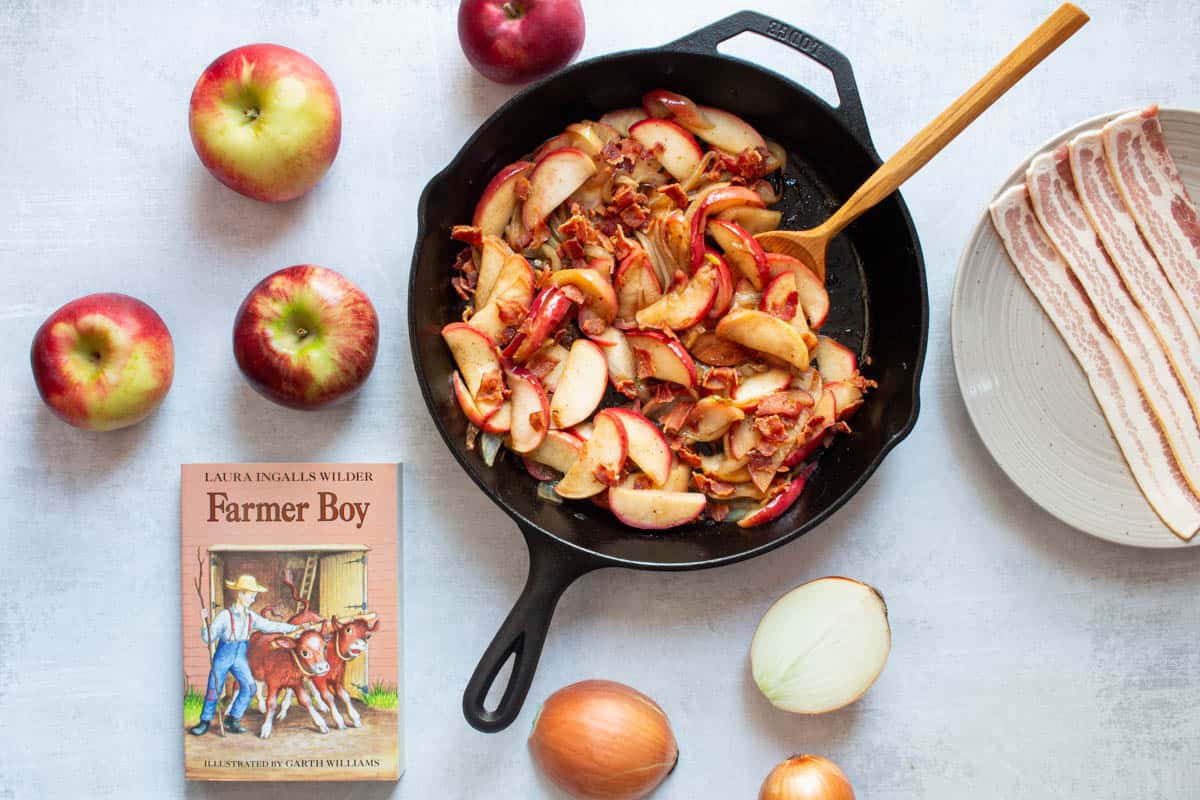
I was introduced to Laura Ingalls Wilder's Little House series when I was in fourth grade, and became obsessed with the books. I was fascinated by her depictions of life on the American prairie in the late 1800s from a child and young adult's point of view. I wanted to wear a calico dress and tie my braids with ribbons! I wanted to churn butter and thresh wheat and break ground on my own homestead! (And arguably still do!)
As anyone who has read any of the Little House books knows, Wilder's vivid descriptions of food are a significant part of every story. She spends pages meticulously detailing everything from the simplest campfire fare like cornmeal cakes fried in salt pork to celebratory treats like "vanity cakes" (a type of puffed-up doughnut) and Christmas candy.
This is perhaps most evident in the book that isn't about Laura's life at all, but is instead inspired by the childhood of her future husband, Almanzo Wilder.
About Farmer Boy
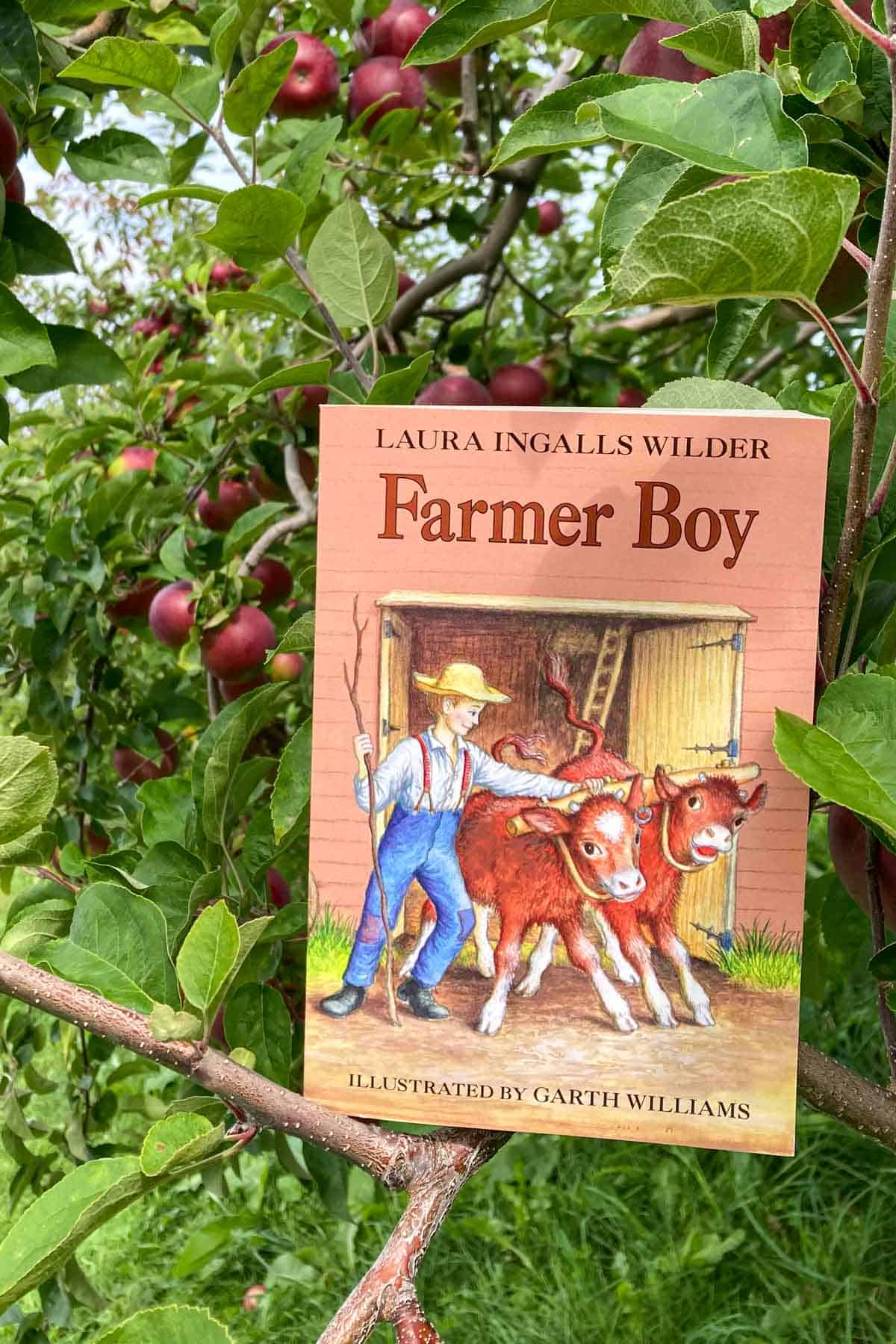
Laura Ingalls Wilder published Farmer Boy in 1933 as the second book in the Little House series, following Little House in the Big Woods, which is a fictionalized account of her own early childhood in rural Wisconsin. Farmer Boy follows a year in 9-year-old Almanzo Wilder's life from 1866-1867. Almanzo grew up on a thriving dairy farm in upstate New York, where he and his brother and sisters undertook endless chores to keep the farm running without electricity or machinery. The book describes stories of their hard work and also their occasional mischief as siblings (some things never change).
But, the food. I have clear memories of reading passages from Farmer Boy aloud with my best friend on the school bus on the way home from school, both of us absolutely starving and swooning. Roasts and pies and homemade ice cream practically burst off of every page!
And it's no wonder that Laura fixated on her husband's tales of bountiful, overflowing tables in her writing. Though sanitized and glossed over in the fictionalized version of her life in her books, her own childhood on the prairie was marked by long periods of scarcity and hunger. In addition, in her Pulitzer Prize-winning biography of Ingalls Wilder, Prairie Fires, writer Caroline Fraser notes the historical context in which Farmer Boy was published. She writes, “...in its lingering, loving portrayal of the mouthwatering abundance of farmhouse fare, it gestures towards the Depression’s straitened circumstances.”
It's worth noting here that despite their beloved status to me and to many others, the Little House books also contain troubling stereotypes and depictions of Native and Black Americans that are hurtful and damaging. Both things can be true--you can love a piece of culture, and it can also have problematic elements that need to be addressed. As essayist Roxane Gay notes in this article about the controversy, “The books just have to be taught in context, and the proper context, not revisionist context.” For more resources to learn how to have productive conversations with children about race and racism encountered in books, I recommend these resources from the Greater Good Science Center and PBS Kids.
Recipe Inspiration
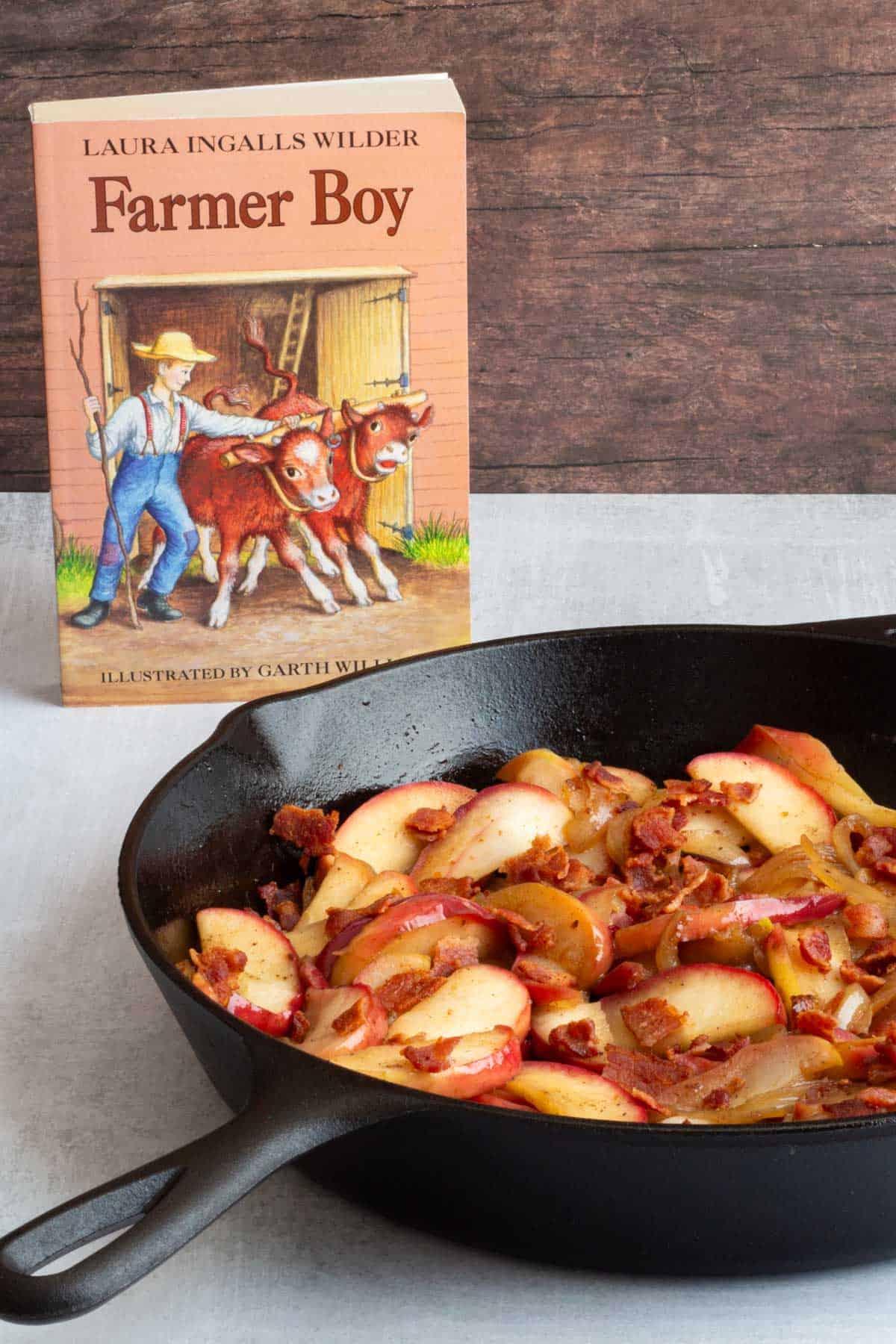
With its overflowing depictions of food on practically every page, it was hard to choose which recipe to develop for Farmer Boy. In the end, Almanzo himself tipped the scales for me. In a scene where he is stocking the ice house with his brother Royal, Almanzo strikes up a conversation about their favorite foods:
They talked about spareribs, and turkey with dressing, and baked beans, and crackling cornbread, and other good things. But Almanzo said that what he liked most in the world was fried apples 'n' onions. When, at last, they went in to dinner, there on the table was a big dish of them! Mother knew what he liked best, and she had cooked it for him.
Laura Ingalls Wilder, Farmer Boy
I remember being mystified by this choice when reading this book as a kid. How could Almanzo pick such a strange-sounding side dish over all of these other glorious options? And, furthermore, what were onions doing mixing with apples anyways? It had to be good, but I just couldn't picture what this dish could be. All of these years later, it was time to find out.

Fortunately for me, author Barbara M. Walker did an incredible deep-dive into historically accurate recipes of the era in The Little House Cookbook. She did extensive research into the ingredients and cooking methods available to cooks like Mother Wilder and Ma Ingalls at the time, and recreated recipes as those families would have enjoyed them.
I tried her recipe for Fried Apples 'n' Onions, and it really was delicious! The alchemy of onions fried in salty pork fat until jammy, topped with sweet and tender apples, really did convince me that Almanzo was onto something.
To put my own spin on the recipe and make it easier for kids, I made a few tweaks in my own development. Firstly, I scaled the recipe down to make it less prep work and just right as a side dish for four people. I chose to go with bacon over salt pork for its convenience and smoky flavor. Cooking the bacon in water first (a fun trick I learned while working at ATK) helped minimize dangerous splatters on the stove. And rather than serve the cooked bacon on the side, I crumbed it up and sprinkled it over the finished dish so every bite would have a crispy, salty morsel.
As for the apples, though Walker's recipe called for coring and cutting them into rings, I found that to be tricky knife work for kids (round apples are wobbly!). Cutting the apples around the core into slabs with flat sides, then slicing those pieces flat-side-down into ¼-inch-thick wedges was much more stable on the cutting board. Using tart apples balanced out the sweet onions and brown sugar, and a sprinkle of salt brought everything together.
Ingredients You'll Need
This simple side dish comes together with just a handful of ingredients, and they may already be in your pantry and fridge. You'll need:
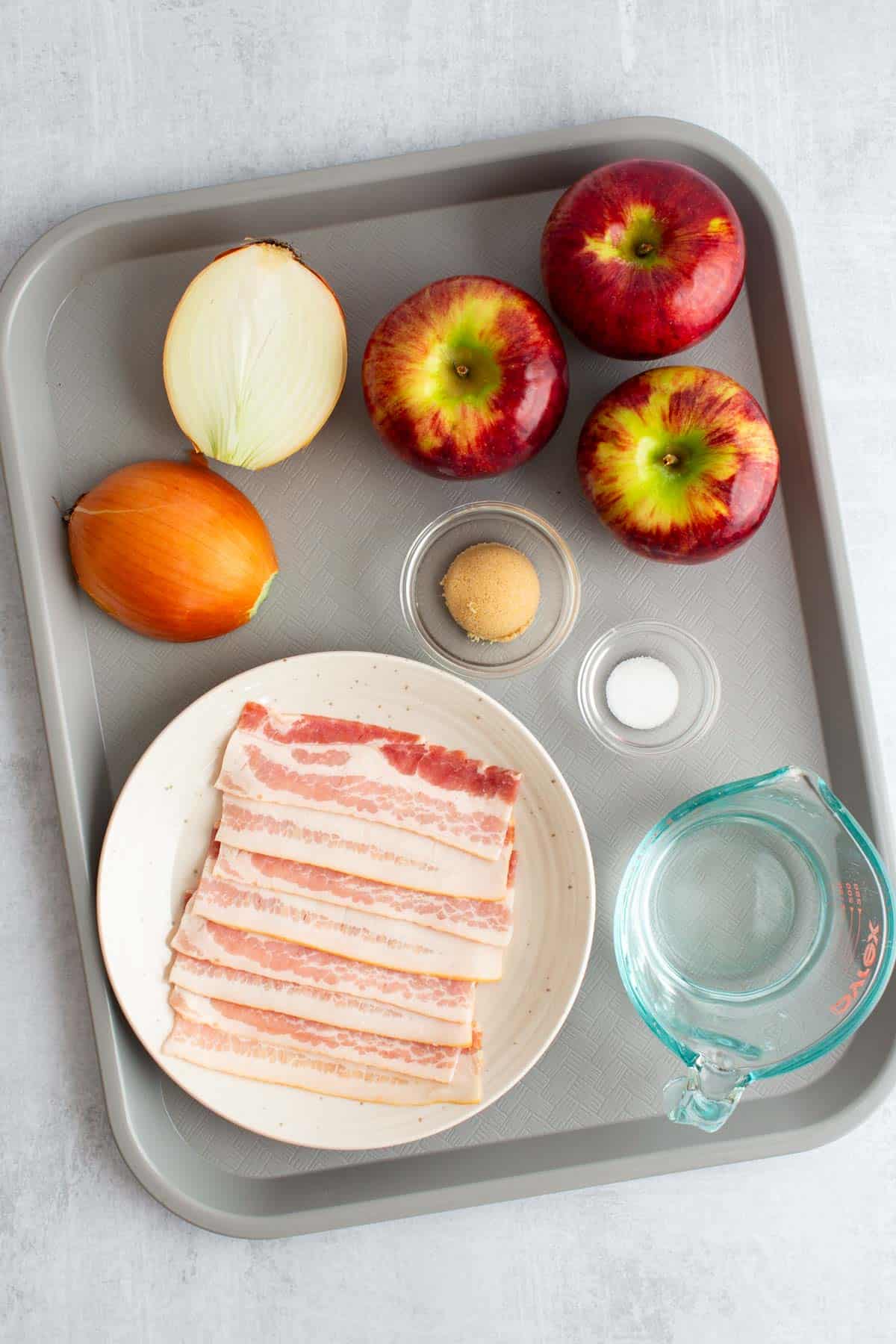
- Tart apples (Cortland, Granny Smith, Jonathan, Northern Spy, or Pink Lady would all work well)
- Yellow onions (1 large or 2 small)
- Water
- Bacon
- Brown sugar
- Salt
As with every recipe, before you start cooking, make sure to measure out and prepare your ingredients ahead of time. Then, you'll have everything you need when you need it! For all of the ingredient measurements and details, see the recipe card below.
How to Make Fried Apples and Onions
The full recipe with detailed timing and instructions is below, but here is an overview and some key moments to look out for along the way:
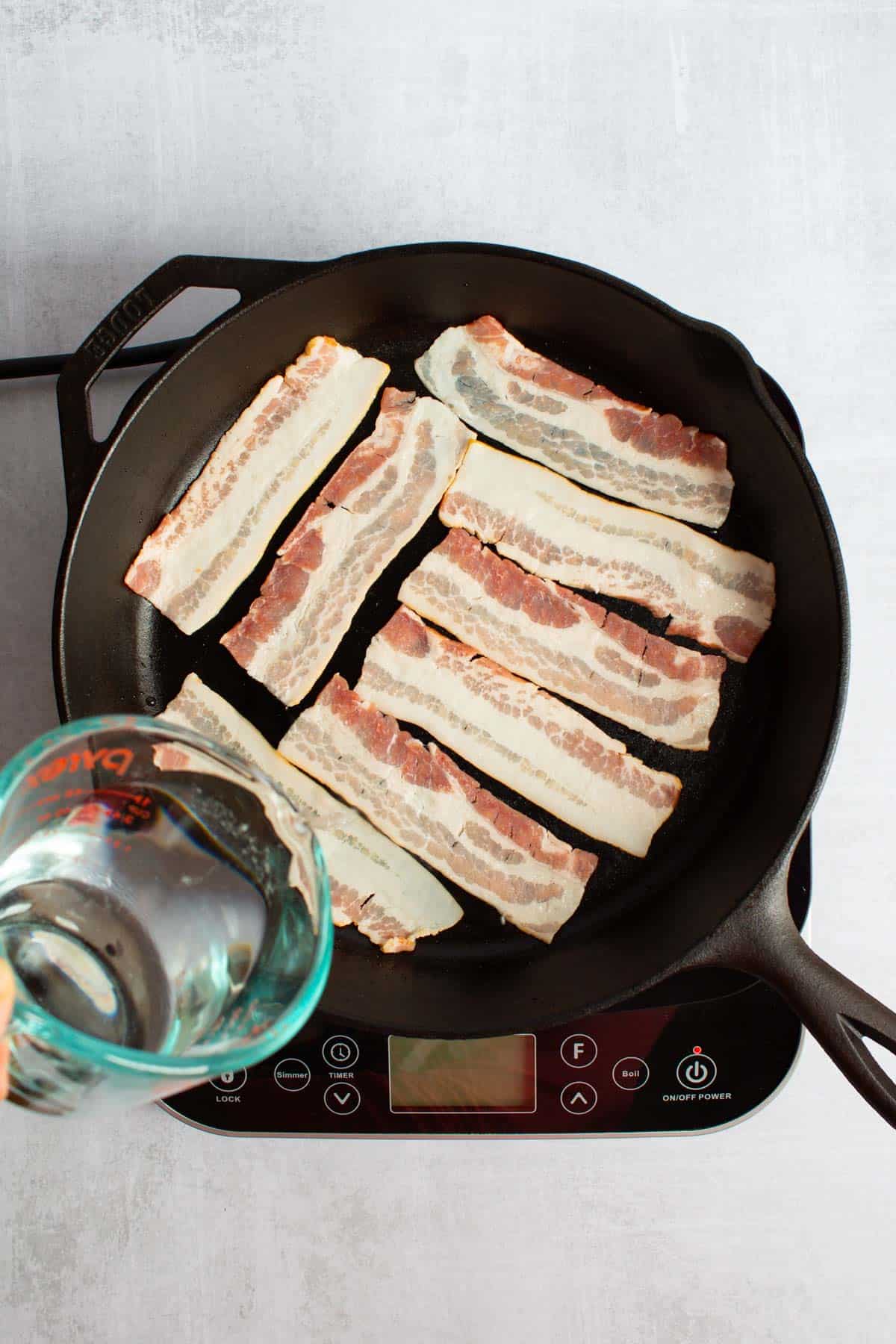
- Cook the bacon: Lay halved slices of bacon in a cold skillet and pour water over the top. This will help reduce splatters while the bacon cooks.
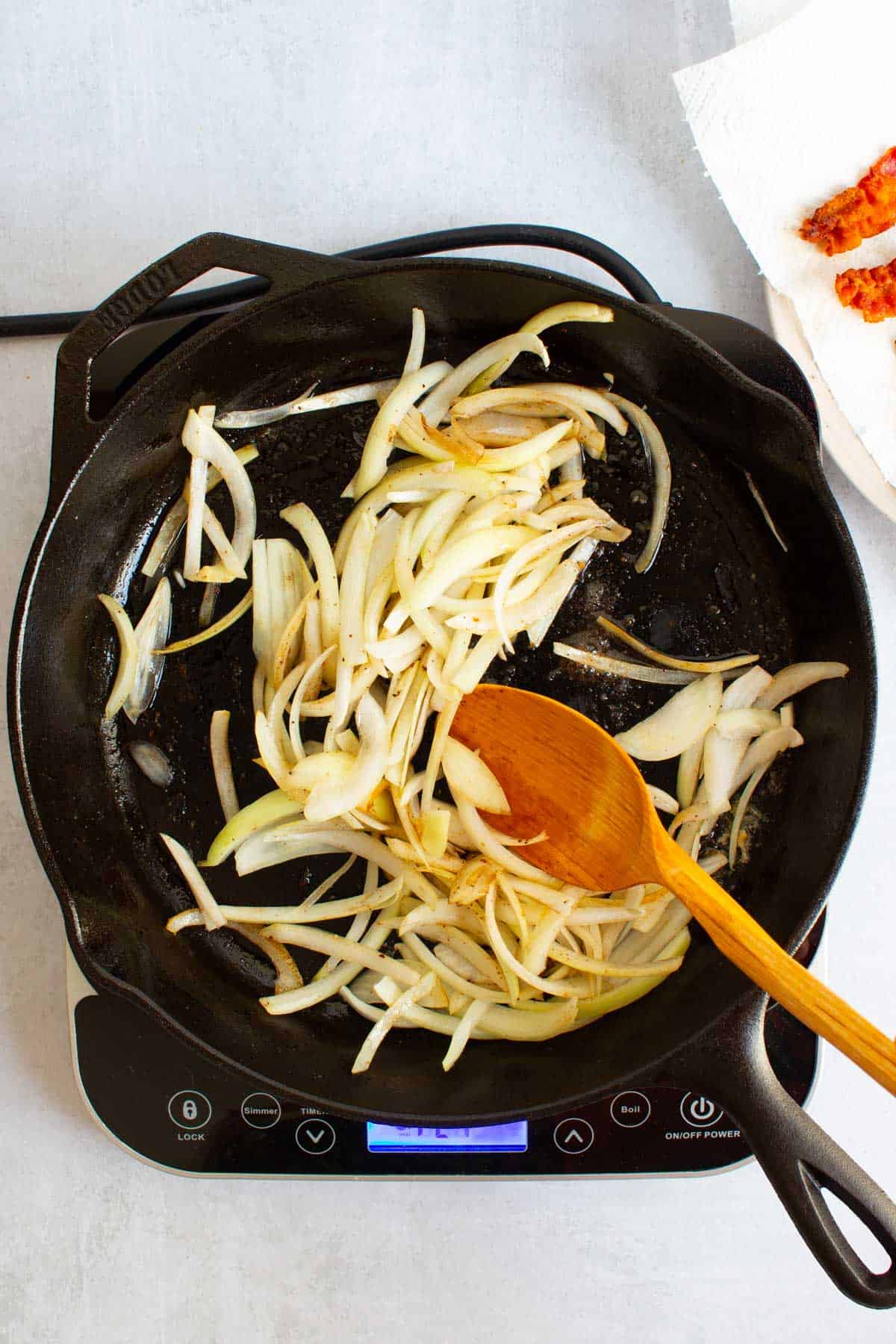
- Cook the onions: After the bacon is cooked, cook sliced onions in the leftover bacon fat in the skillet until they are lightly golden brown.
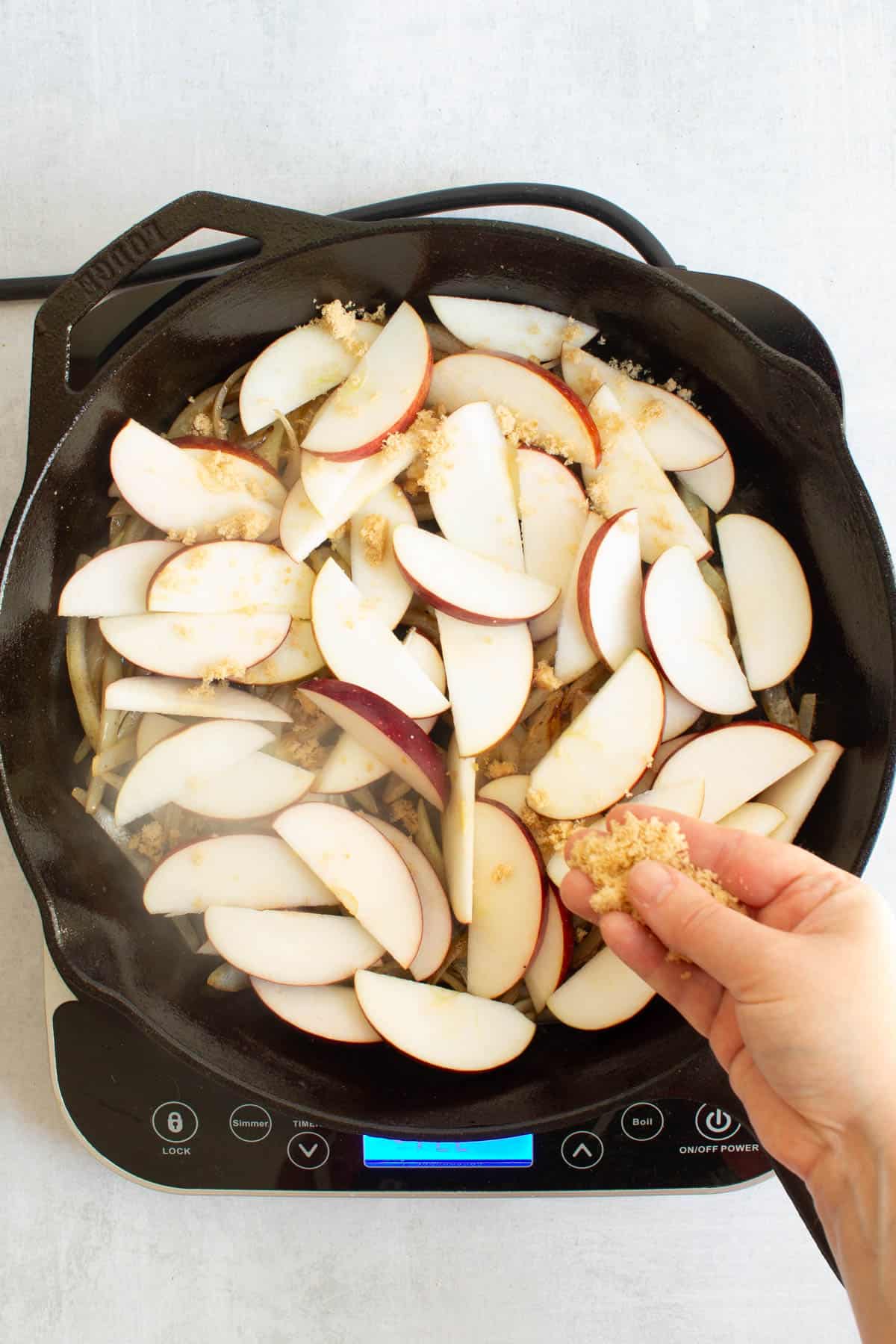
- Top with apples: Add sliced apples in a layer on top of the onions and sprinkle with brown sugar and salt.
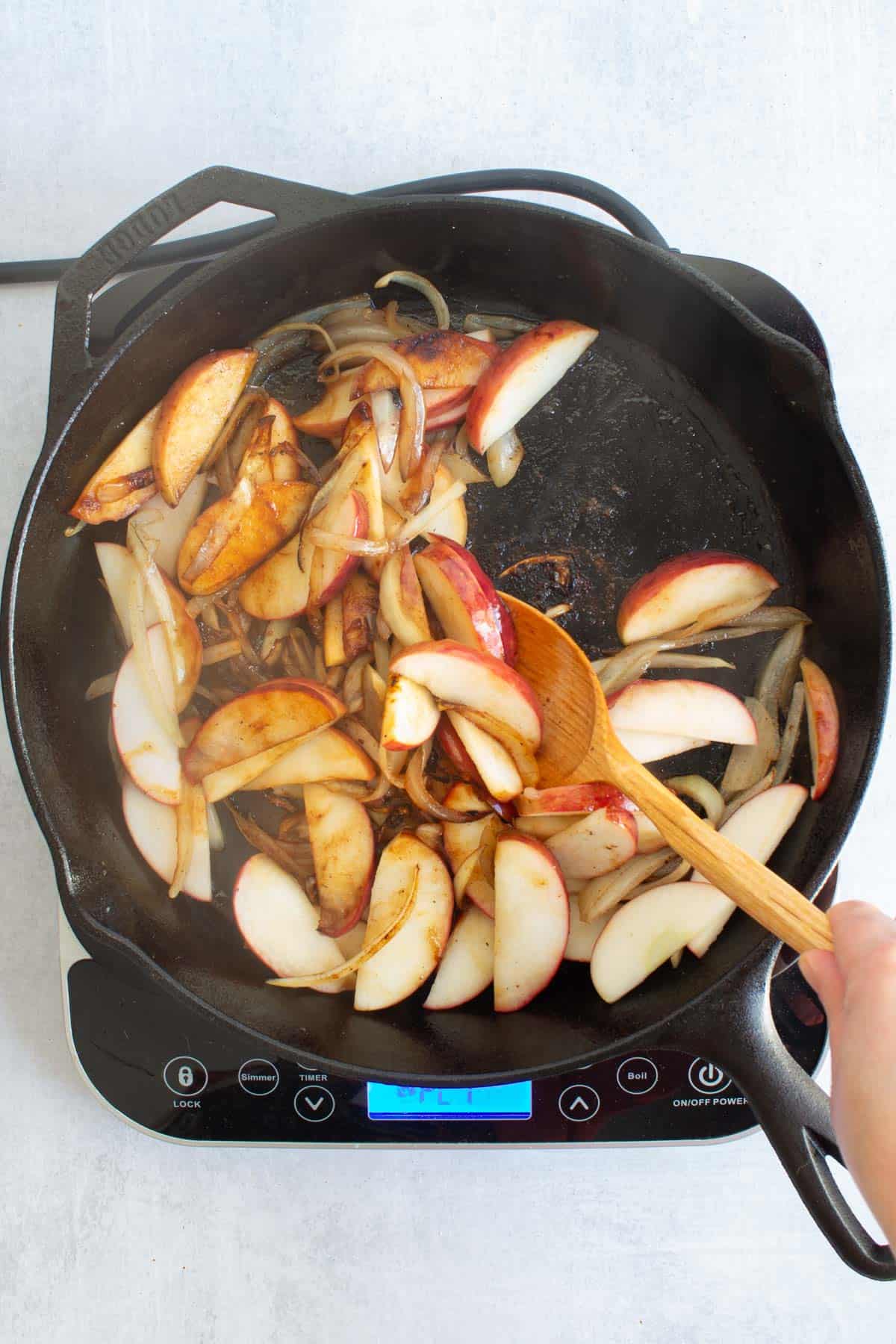
- Cook and stir: After cooking covered for a few minutes, stir everything together until the apples and onions are evenly coated with sauce.
Why This Recipe Is Great for Kids
I've spent years writing cookbooks and creating recipes that are safe, fun, and engaging for kids and home cooks of all ages. Here are some key features of this recipe that make it perfect for kids and families to make together at home:
- This is an old-fashioned dish that you and your kids may not have encountered before. It's an excellent chance to try something new! The sweetness of the dish might win over any onion skeptics.
- Kids can practice basic knife skills by learning how to slice onions and how to core and slice apples. If they're not confident with a knife yet, grown-ups can do this part, and kids can focus on adding the ingredients to the pan.
- Adding water to the pan with the bacon helps minimize the pops and splatters that can happen when bacon cooks, making this recipe safer for kids. It will still sizzle towards the end, though, so make sure kids (and grown-ups!) are careful and stand back from the stove at that stage.
Let's Cook!
Gather your equipment, measure your ingredients, and get cooking with this kid-friendly recipe! If you loved making it together, please leave five stars and share your stories in the comments.
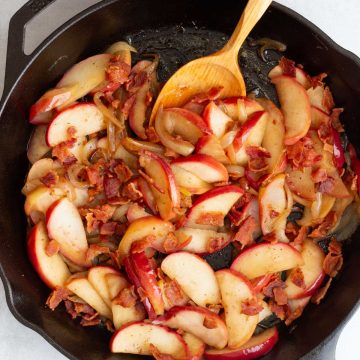
Fried Apples and Onions
Good To Know
- Cutting the bacon slices in half helps them to cook more evenly in the pan. You can use kitchen shears or a chef’s knife to cut the slices in half; just make sure to wash the cutting board and knife with hot, soapy water if you’re going to use them again to slice your apples and onions. (Nothing that touches raw meat should be used for anything else before being washed when cooking.)
- Tart apples that hold their shape during cooking are great to use in this recipe. Cortland, Granny Smith, Jonathan, Northern Spy, or Pink Lady apples all work well, but you can use whichever apples you have on hand, if you like.
- If you feel comfortable multitasking, you can prep your apples and onions while the bacon is cooking.
Equipment You'll Need
- Large plate
- Paper towels
- 12-inch skillet with lid (cast iron is great for this recipe, if you have it!)
- Tongs
- Oven mitts
- Wooden spoon
Measure Your Ingredients
- 4 slices bacon, cut in half crosswise
- ½ cup water
- 1 large or 2 small yellow onions, peeled and sliced
- 3 tart apples, cored and sliced into ¼-inch-thick wedges (see note)
- 1 tablespoon packed brown sugar
- ¼ teaspoon table salt
Let's Cook!
- 4 slices bacon, cut in half crosswise, ½ cup waterLine a large plate with paper towels and set it next to the stove. Lay the bacon strips down in a cold 12-inch skillet. Wash your hands. Pour the water over the bacon in the skillet.
- Cook over high heat until the water comes to a boil (big bubbles will vigorously break all over the surface). Reduce the heat to medium and continue cooking until the water evaporates, 5 to 8 minutes.
- Reduce the heat to medium-low. Continue cooking, using tongs to flip the bacon slices over occasionally, until both sides are evenly browned and the bacon is crisp, 8 to 10 minutes. (The bacon should be sizzling gently, but the fat may still occasionally pop, so stand back from the pan and be careful when flipping.)
- Turn off the stove and use oven mitts to carefully slide the skillet to a cool burner (cast iron skillet handles can get extra hot during cooking; this step is best done by an adult).
- Use the tongs to carefully transfer the cooked bacon to the paper towel-lined plate to cool. Let the bacon fat cool slightly, at least 2 minutes.
- 1 large or 2 small yellow onions, peeled and slicedCarefully add the sliced onions to the bacon fat left in the skillet (the fat will still be hot, so be careful of splashes). Return the skillet to medium heat and cook, stirring occasionally with a wooden spoon, until the onions are softened and beginning to brown, 3 to 4 minutes.
- 3 tart apples, cored and sliced into ¼-inch-thick wedges, 1 tablespoon packed brown sugar, ¼ teaspoon table saltCover the onions with the apple slices in an even layer. Sprinkle the brown sugar and salt evenly over the top of the apples. Place a lid on the skillet and cook until the apples are tender, about 5 minutes.
- While the apples and onions are cooking, crumble the bacon slices into small pieces.
- When the apples are ready, use an oven mitt to remove the lid from the skillet. Stir the mixture with the wooden spoon until the apples and onions are evenly coated with sauce, then turn off the stove. Sprinkle the crumbled bacon over the top and serve.
Conversation Starters
While enjoying your apples and onions, talk about the book and what it was like to cook the recipe together. You can help young readers make connections to the book and share your own memories and stories with them with the following prompts:
- Laura Ingalls Wilder and Almanzo Wilder grew up in the 1860s, over 160 years ago! What was the same and what was different about life for kids at that time?
- Almanzo chose Fried Apples and Onions as his all-time favorite food. What is yours, and why?
- Apples and onions are two ingredients that don't naturally seem to go together (but they do!). What are some other foods you like that are surprising combinations? (Maybe peanut butter and bacon? Honey drizzled on pizza? French fries dipped in a milkshake?)
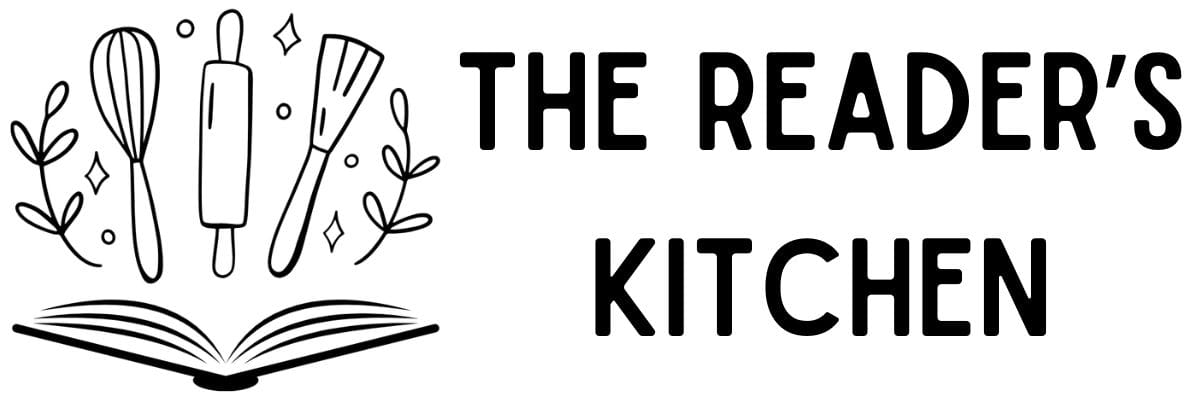

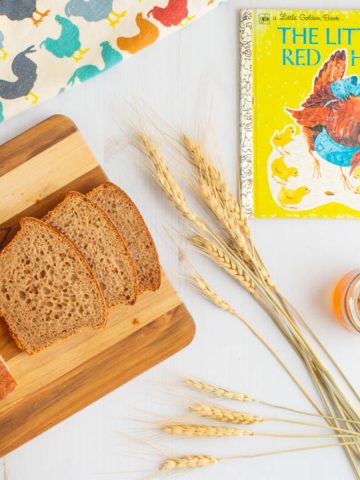
Comments
No Comments